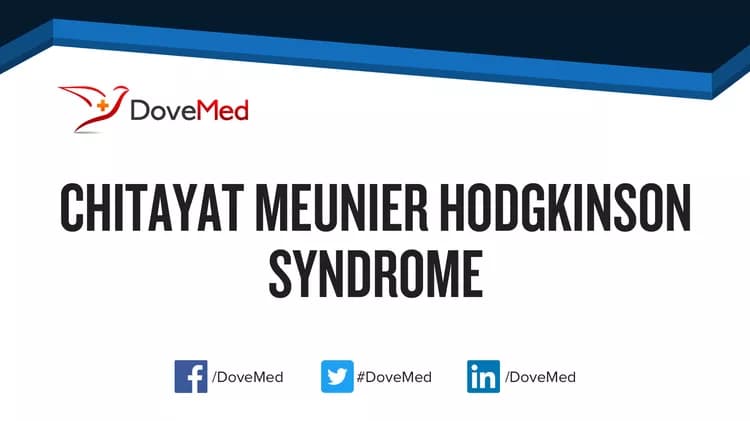What are the other Names for this Condition? (Also known as/Synonyms)
- Pierre Robin Syndrome, Faciodigital Anomaly
- Robin Sequence with Facial and Digital Anomalies
What is Chitayat Meunier Hodgkinson Syndrome? (Definition/Background Information)
- Chitayat Meunier Hodgkinson Syndrome is characterised by the association of Pierre Robin sequence (retrognathia, cleft palate and glossoptosis) with facial dysmorphism (high forehead with frontal bossing) and digital anomalies (tapering fingers, hyperconvex nails, clinodactyly of the fifth fingers and short distal phalanges, finger-like thumbs and easily subluxated first metacarpophalangeal joints)
- Growth and mental development were normal
- Transmission appears to be X-linked recessive. It has been described in two half-brothers born to the same mother
(Source: Chitayat Meunier Hodgkinson Syndrome; Orphanet, National Institute of Health and Medical Research (INSERM), Paris.)
Who gets Chitayat Meunier Hodgkinson Syndrome? (Age and Sex Distribution)
- Chitayat Meunier Hodgkinson Syndrome is a rare congenital disorder. The presentation of symptoms may occur at birth
- Males and females may be affected; however, all the reported cases have been observed in male children (since the condition may be X-linked)
- Worldwide, individuals of all racial and ethnic groups may be affected
What are the Risk Factors for Chitayat Meunier Hodgkinson Syndrome? (Predisposing Factors)
- A positive family history may be an important risk factor, since Chitayat Meunier Hodgkinson Syndrome can be reportedly inherited
- Currently, no other risk factors have been clearly identified for the syndrome
It is important to note that having a risk factor does not mean that one will get the condition. A risk factor increases one’s chances of getting a condition compared to an individual without the risk factors. Some risk factors are more important than others.
Also, not having a risk factor does not mean that an individual will not get the condition. It is always important to discuss the effect of risk factors with your healthcare provider.
What are the Causes of Chitayat Meunier Hodgkinson Syndrome? (Etiology)
- The exact cause of development of Chitayat Meunier Hodgkinson Syndrome is presently unknown
- It is believed to be a genetic disorder that is inherited in an X-linked recessive manner
What are the Signs and Symptoms of Chitayat Meunier Hodgkinson Syndrome?
The signs and symptoms of Chitayat Meunier Hodgkinson Syndrome may include:
- Clinodactyly of the 5th finger
- Easily subluxated first metacarpophalangeal joints
- Frontal bossing
- Glossoptosis
- High forehead
- Hyperconvex nail
- Micrognathia
- Pierre-Robin sequence
- Short distal phalanx of finger
- Tapered finger
(Source: Chitayat Meunier Hodgkinson Syndrome; Genetic and Rare Diseases Information Center (GARD) of National Center for Advancing Translational Sciences (NCATS), USA.)
How is Chitayat Meunier Hodgkinson Syndrome Diagnosed?
Chitayat Meunier Hodgkinson Syndrome is diagnosed on the basis of the following information:
- Complete physical examination
- Thorough medical history evaluation
- Assessment of signs and symptoms
- Laboratory tests
- Imaging studies
- Biopsy studies, if necessary
Many clinical conditions may have similar signs and symptoms. Your healthcare provider may perform additional tests to rule out other clinical conditions to arrive at a definitive diagnosis.
What are the possible Complications of Chitayat Meunier Hodgkinson Syndrome?
The complications of Chitayat Meunier Hodgkinson Syndrome may include:
- Facial deformities
- Emotional stress
Complications may occur with or without treatment, and in some cases, due to treatment also.
How is Chitayat Meunier Hodgkinson Syndrome Treated?
Presently, there is no cure for Chitayat Meunier Hodgkinson Syndrome. The treatment is usually given to manage the signs and symptoms and any complications that develops.
How can Chitayat Meunier Hodgkinson Syndrome be Prevented?
Currently, Chitayat Meunier Hodgkinson Syndrome may not be preventable, since it is reportedly a genetic disorder.
- If there is a family history of the condition, then genetic counseling will help assess risks, before planning for a child
- Active research is currently being performed to explore the possibilities for treatment and prevention of inherited and acquired genetic disorders
Regular medical screening at periodic intervals with tests and physical examinations are recommended.
What is the Prognosis of Chitayat Meunier Hodgkinson Syndrome? (Outcomes/Resolutions)
- The prognosis of Chitayat Meunier Hodgkinson Syndrome is dependent upon the severity of the signs and symptoms and associated complications, if any
- Individuals with mild conditions have better prognosis than those with severe symptoms and complications
- Typically, the prognosis is considered to be good
Additional and Relevant Useful Information for Chitayat Meunier Hodgkinson Syndrome:
The following DoveMed website link is a useful resource for additional information:
Related Articles
Test Your Knowledge
Asked by users
Related Centers
Related Specialties
Related Physicians
Related Procedures
Related Resources
Join DoveHubs
and connect with fellow professionals


0 Comments
Please log in to post a comment.